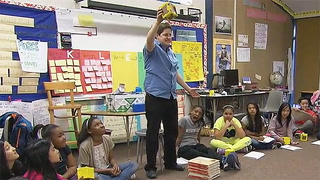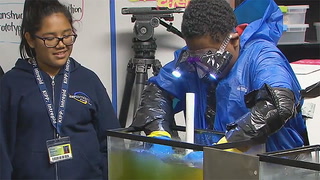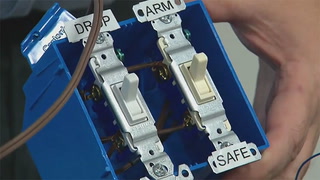Teacher: No pressure.
Student: I'm thinking we should make like an X right here, because X's are strong.
Student: Okay. Let's do it again.
Card:
Engineering Design in the Classroom: Composites & Polymers for the Planet
Jessica Levine: Hey, so what's a polymer? Inez?
Student: A polymer is a long chain of molecules bonded together chemically.
Jessica Levine: My name is Jessica Levine and I teach sixth grade science at Eckstein Middle School in Seattle, Washington. I'm a curriculum designer at heart.
Lower Third:
Jessica Levine
6th Grade Science Teacher
Eckstein Middle School, Seattle, WA
+++ 00:00:35 +++
Jessica Levine: I love to develop curriculum and opportunities that work with the whole student and learning in multiple levels. And I'm not just about science and engineering. And when I first learned of the Boeing project, I said, "That's where I want to be."
Jessica Levine: I want to introduce you to Kay and Jill. Jill's in the red. And they're the Boeing engineers that I've been designing this curriculum with for the last three months. And they are here to help because this part, the testing of plastics, is what they do professionally as chemical engineers all the time. And they came to see you, young chemical engineers, so that you can learn from them as well.
Lower Third:
Jill Seebergh
Technical Fellow, Chemical Engineer
The Boeing Company, Seattle, WA
+++ 00:01:09 +++
Jill Seebergh: It was really fascinating, this opportunity to really work in partnership closely with a teacher, which was something new for me, to develop a two week curriculum, which seemed like a really tall order, a big challenge.
Jessica Levine: Quick thoughts about your plastic?
Student: Ours is kind of a low density and is very flimsy, but that's actually the kind of plastic we were hoping to make.
Jessica Levine: Awesome.
Jessica Levine: Today's lesson was about gathering quantitative and qualitative data about the biopolymers that we had created yesterday.
Lower Third:
6th Grade Science Class Previous Day
Teacher's Video
+++ 00:01:41 +++
Jessica Levine: Yesterday students made their own bioplastics. After a little bit of work on the previous day, they were able to take a base formulation, modifying and selecting their own starches and somewhat of their own additives and plasticizers. It's a ten lesson unit introducing students to the company, Premier Polymer Providers. And a young teenage engineer in Turkey who has made
+++ 00:02:10 +++
banana plastics, saving her beloved Bosphorus and recognizing there's not a significant amount of petroleum-based pollution and plastics in her environment.
Jill Levine: We've got an awesome opportunity to do some quantitative testing. So you've got your samples. And what I want to do today is review how we're going to test your samples so that we can get some data and then we'll have a chance to make optimizations in the next couple weeks.
Lower Third:
Kay Blohowiak
Technical Fellow, Adhesives & Bonding
The Boeing Company, Seattle, WA
+++ 00:02:37 +++
Kay Blohowiak: This is one of the first projects that I've seen that really focuses on engineering. So Boeing does a lot of stem activities and we do a lot of work in that area. But this project was really focused on developing an engineering curriculum and getting kids interested in engineering at the early levels.
Jessica Levine: So we're going to stretch our plastic. Take a look at the video here and see how we're going to do that. You're going to hold on to that really tight and you're going to pull slow and steady to stretch and elongate. You're going to read the ruler right at the point where your fingers end up where it snaps.
Student: Nine inch.
Student: Okay. So nine and a half.
+++ 00:03:16 +++
Jessica Levine: The other test that you are going to do is the tensile strength test. Flip your page so you can look at the procedures for that.
Jessica Levine: You're going to take a sample today that's called a dog bone shape. And we've got templates for you up front, so you can cut this dog bone shape. And you're going to secure it with two Popsicle sticks and a binder clip. Okay. And then you're going to hang it from the two chairs. Okay. And then hanging from the paper clips, you're going to hang washers. And this time, you're testing the strength until it snaps.
+++ 00:03:50 +++
Student: The strength test, will we be measuring the amount of washers that we put on?
Jessica Levine: Correct.
Student: Okay.
Jessica Levine: Quantitative testing is a necessary part of being an engineer. And the biopolymers that they had formulated in the days prior needed to go through a couple of different quantitative and qualitative testings, so that they would be able to optimize their formulations the next time.
+++ 00:04:11 +++
Jessica Levine: We got a lot of adults here to help you so that you can get to it. Again, templates are up front with plastic samples to learn the methodology before you try to cut the template out of your own prototype.
Jessica Levine: The next generation's science standards focus a lot on engineering practice. It just allowed me to strengthen the work of engineering to let my students be curious, be inquisitive, gather data, consult each other for information, and work as scientists.
+++ 00:04:44 +++
Jessica Levine: Last important thing. Safety. Flying washers, flying paper clips might mean a good call for?
Student: Goggles.
Jessica Levine: Goggles. Okay. Thank you.
Student: Let's start with this.
Jessica Levine: Good idea.
Student: We think that right here would be a good area to cut the sample.
Jessica Levine: What's one thing you might notice qualitatively about it?
Student: It's really.
Student: it's brittle.
Student: It's really brittle.
Jessica Levine: It's really brittle. And write that down, right.
Student: So we're at eight and I got to sixteen.
+++ 00:05:13 +++
Kay Blohowiak: I was really excited to get into the classroom today, because as we were devising this curriculum, you're never quite sure how your experimental plan will work and how well it will be translated to the student level. Because you may write one thing and they may do something completely different.
Jessica Levine: Why do you think the Popsicle sticks are there in the first place?
Student: To hold it together.
Student: To hold it in place.
+++ 00:05:40 +++
Jessica Levine: Yeah. Did you know that that took a little bit of engineering on our part to figure out how we were going to get it to hold in place?
Jill Seebergh: You don't have to make the samples this long. You could make them like half the size. As long as you record it. You just measure what your sample is. This is part of engineering. If we can't cut it this size, we're going to improvise.
Student: Yeah.
Student: Yeah.
Jill Seebergh: And kind of come up with something that works.
Student: Well, here. Put it on the other...
Student: Wait we're gonna break!
Student: Ah! Oh!
Student: It worked. Did you count?
Student: I already counted it.
Student: Forty washers.
Student: That's awesome.
Student: Oh, it's starting to... oh!
+++ 00:06:04 +++
Kay Blohowiak: It was great to see how excited they were to do the experiment. A lot of them did extra research outside of the curriculum and brought things to the table that we're going to look up and incorporate it into the lesson plan.
Student: So if the plastic was in a different shape, would it-- would we be able to put more washers on it before it broke?
Jessica Levine: The dog bone shape here is a sort of industry standard for testing tensile strength.
+++ 00:06:31 +++
Jessica Levine: They were really delighted today to get to work with those engineers. Because they in class were modeling exactly what happens with real chemical engineers. And just to have real chemical engineers come and work with them, is very validating to know that the work they're doing is for real.
Jessica Levine: Take a look at these questions up there. Anyone want to start with the first one?
Student: I thought that we were engineers because we were making our own plastic and when we tested it, we were deciding if we wanted to make it better what we should do, which is what engineers do.
+++ 00:07:01 +++
Kay Blohowiak: It's so important that every single student that goes through the school system today comes out with some degree of technical knowledge and engineering knowledge, because our world is so complicated. So everybody needs to have a basic technical understanding. And there's really no excuse why people can't think that that can be part of what they know and what they own as knowledge.
Jessica Levine: For homework this weekend, I want you to think about your next steps. If your plastic was too brittle, look through your booklet and see what kind of things you might have to change for that next time.
+++ 00:07:33 +++
Jessica Levine: Incorporating engineering design principles into your science classroom is not as difficult as it looks. I think the first step as a teacher is to recognize that engineering can be messy, and so can science. But having that growth mindset for yourself as a teacher is really important to recognize that it might not go well. And to be transparent with your students about that learning process, it builds trust, it builds relationships in the classroom that are paramount at the middle school level, and allows you to do things like drop washers on the desks and have a bit of ordered chaos.
+++ 00:08:07 +++
Jessica Levine: Take your right hand. Raise it above your head. Put it over your left shoulder and pat yourself on the back. Nicely done. Have a good weekend, engineers.
GFX:
TCH
Teaching Channel
#### End of C0804_002003_Jessica_CLASS.FINAL_SD.mp4 ####
















22 Comments
Hamdan Yusoff Aug 29, 2018 6:03am
I am trying to download these lessons, but none are available from any link. Thanks!
Sophie Valena Apr 3, 2018 9:01am
Melinda Nunnikhoven Sep 22, 2017 9:48am
Sherri Devine Sep 21, 2017 4:53pm
Melinda Nunnikhoven Sep 21, 2017 4:22pm